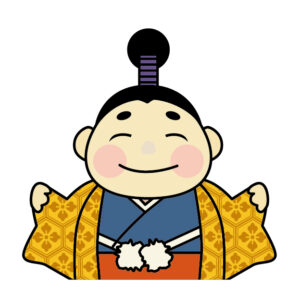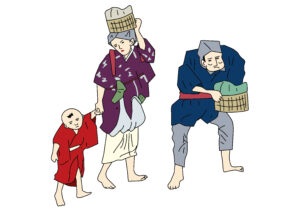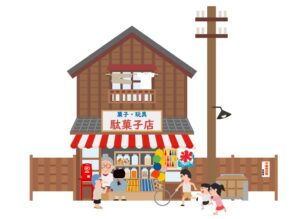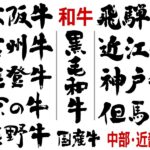Contents
Definition of "kasi"
"Kasi" means snack and candies. Usually you add "o" in front and say "Okasi". When you hear "Okasi", you picture those packaged snacks and candies that are sold at super markets or convenience stores. I'm a big fan of okasi, all kinds of okasi. Let me explain a bit more about the word "(o)kasi".
Roughly speaking:
KASI・かし・菓子
- Okasi・おかし・お菓子 = snacks and candies in general, but usually not so fancy
- Yōgasi・ようがし・洋菓子 means Western (yō) kasi = Cakes, pies, cream puff, etc. that are of Western origin.
- Wagasi・わがし・和菓子 means Japanese (wa) kasi = Manju, moti, yokan, etc that are of Japanese origin.
- (O)chagasi・おちゃがし・お茶菓子 originally means fancy small Wagasi served at tea ceremony.
- Dagasi・だがし・駄菓子 means (nostalgic) fun sweets = this is my definition, and I will explain more after this.

Categories above overlap here and there. But when you hear Yōgasi and Wagasi, you picture those that you buy at specialty stores that are freshly made and won't last long. Ochagasi gives an impression that it's high-end Wagasi.
When you hear Okasi and Dagasi, you picture those mass produced relatively longer lasting snacks and sweets that you buy anywhere. BUT! Dagasi has a very special ring to it.
DAGASI・だがし・駄菓子 so nostalgic
"DA・だ・駄", this character itself means "inferior", "worthless", "low value", obviously not a praising term.
Back in Edo era (1600~1868) when refined/white sugar was a precious commodity, sweets made with white sugar were privileged items enjoyed only by high ranked samurai, thus, those were called "Jyō-gasi" (Jyō means high/high class).
Farmers and town people, if lucky, got to eat some sweets too, but those were made with unrefined black/brown sugar. To differentiate the two, latter was called "Da-gasi". So the difference was simply the ingredients and price/availability.
As time went by, white sugar became abundant and most Dagasi were made with white sugar as well. But the recipe, looks, and taste of Dagasi have been passed down through the ages.
So today, when you hear Dagasi, even though they are manufactured in the state-of-the-art factories, you think of modest, cheaper, retro/nostalgic snacks and candies.
Dagasi - if you grew up in Syōwa era
 When I was a little child, in Syōwa era, we already had modern big brand snacks and candies that we simply called "Okasi". Those included packaged chocolate, cookies, caramel, and gum.
When I was a little child, in Syōwa era, we already had modern big brand snacks and candies that we simply called "Okasi". Those included packaged chocolate, cookies, caramel, and gum.
Authentic traditional "Dagasi" were sold only at "Dagasi-ya (Dagasi shop)" which was hard to find. I recall there was one (the only one I knew) between my school and home, not directly on my route .
After school, friends and I took a detour and stopped by the shop without telling our parents since they thought Dagasi was not healthy for kids. (Some items were unwrapped, packed in a jar). The shop was like a wonderland for us. All candies and toys sold there were never sold at the stores we usually shopped.
The old shop keeper (I'm sure he was the owner) was always sitting in the back of the shop (the shop was connected to his residence - common style back then for small shop owners), and took care of all the kids stopped by after school.
By the way, I never saw grown-up customer there. The shop was almost exclusively for elementary school kids.
Those original Dagasi shops are probably all gone since nobody took over the business. When the owners retired, the stores retired as well.
If you find "Dagasi shop" today, that's more likely a revival type of Dagasi shop with modern structure that mimic the antique look.
Popular Dagasi today - from Umaibō to Ramune to Yottyan(yocchan)-ika
The main reason why we don't see traditional Dagasi shop now is because it's not profitable enough. Dagasi must be priced low. ¥10-50 (10c-50c) per piece. Target is mostly kids with small allowance.
If you are a retired person living in a fully paid-off house, can obtain a license to run a small retail shop in the front side of your house, that can be a fun side business if you like kids. But you can earn equal or more money working as a part timer in your neighborhood.
In the olden days, life in general was tougher probably, but society/system overall was easier and lenient on people, more based on trust and common sense. But now, to open a tiny shop in front of your house is a difficult project. It's not a lemonade cart on the sidewalk (I'm not sure if those are required to have a health department license...)
How to try authentic DAGASI from Japan
So, in short, it's not worth running a Dagasi shop in modern day Japan. I mean, if you offer other goods or foods in addition to Dagasi, then it's a different story, a different business plan. I've seen shops with "Dagasi" signage which also serve light lunch, or sell more expensive goods. But selling only Dagasi? No.
But, people love them. Demand is there. Not only from those who feel nostalgic, but also from the post-Syōwa generations who enjoy and appreciate the unique look and flavor that only Dagasi can offer.
That's why and how Dagasi has maintained its own market big enough to produce countless popular brands and manufacturers who specialize in them. They are sold in a section of major supermarkets, convenience stores, and some specialty shops who sell them in bigger volume.
Of course buying online is a great option. Even from overseas, you can order authentic Japanese Dagasi assortment in a box. Below is one of them on Amazon if you are interested (it's a paid ad).
Assorted Authentic Japanese "DAGASI" shipped to you by Amazon (jump to ad)
If you live in Japan, you know already how to get them. If you live in the country or region with big enough Japanese population, you might find Japanese markets like "Mituwa", "Nijiya", and "Marukai". They all have a good selection of "Dagasi".
Typically, "Dagasi" packages are full of funny/crazy manga illustrations, individually packed for 1 serving, and sometimes come with "Omake・おまけ" which is a small toy.
Here is a link to the ranking site that introduces the top 102 popular Dagasi voted by 1,156 viewers of the Japanese. It's in Japanese, but you can scroll down and see pictures of the top 102 products (ranks are shown in red flag on the left top of each product).
DAGASI thrives! Even though they are getting more sophisticated, neatly packed with nice clean image, the flavors are still there. You can enjoy the taste of "Syōwa" era.
See you next time! 
Please note




